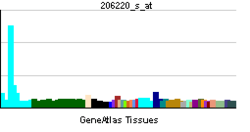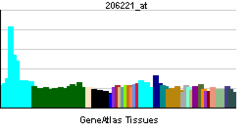RASA3
| RAS p21 protein activator 3 | |||||||||||||
|---|---|---|---|---|---|---|---|---|---|---|---|---|---|
| Identifiers | |||||||||||||
| Symbols | RASA3 ; GAP1IP4BP; GAPIII | ||||||||||||
| External IDs | OMIM: 605182 MGI: 1197013 HomoloGene: 7217 GeneCards: RASA3 Gene | ||||||||||||
| |||||||||||||
| RNA expression pattern | |||||||||||||
 | |||||||||||||
 | |||||||||||||
| More reference expression data | |||||||||||||
| Orthologs | |||||||||||||
| Species | Human | Mouse | |||||||||||
| Entrez | 22821 | 19414 | |||||||||||
| Ensembl | ENSG00000185989 | ENSMUSG00000031453 | |||||||||||
| UniProt | Q14644 | Q60790 | |||||||||||
| RefSeq (mRNA) | NM_007368 | NM_009025 | |||||||||||
| RefSeq (protein) | NP_031394 | NP_033051 | |||||||||||
| Location (UCSC) | Chr 13: 114.75 – 114.9 Mb | Chr 8: 13.57 – 13.68 Mb | |||||||||||
| PubMed search | |||||||||||||
Ras GTPase-activating protein 3 is an enzyme that in humans is encoded by the RASA3 gene.[1][2][3]
The protein encoded by this gene is member of the GAP1 family of GTPase-activating proteins. The gene product stimulates the GTPase activity of normal RAS p21 but not its oncogenic counterpart. Acting as a suppressor of RAS function, the protein enhances the weak intrinsic GTPase activity of RAS proteins resulting in the inactive GDP-bound form of RAS, thereby allowing control of cellular proliferation and differentiation. This family member is an inositol 1,3,4,5-tetrakisphosphate-binding protein, like the closely related RAS p21 protein activator 2. The two family members have distinct pleckstrin-homology domains, with this particular member having a domain consistent with its localization to the plasma membrane.[3]
Interactions
RASA3 has been shown to interact with HCK.[4]
References
- ↑ Cullen PJ, Hsuan JJ, Truong O, Letcher AJ, Jackson TR, Dawson AP, Irvine RF (Sep 1995). "Identification of a specific Ins(1,3,4,5)P4-binding protein as a member of the GAP1 family". Nature 376 (6540): 527–30. doi:10.1038/376527a0. PMID 7637787.
- ↑ Lockyer PJ, Bottomley JR, Reynolds JS, McNulty TJ, Venkateswarlu K, Potter BV, Dempsey CE, Cullen PJ (Feb 1998). "Distinct subcellular localisations of the putative inositol 1,3,4,5-tetrakisphosphate receptors GAP1IP4BP and GAP1m result from the GAP1IP4BP PH domain directing plasma membrane targeting". Curr Biol 7 (12): 1007–10. doi:10.1016/S0960-9822(06)00423-4. PMID 9382842.
- ↑ 3.0 3.1 "Entrez Gene: RASA3 RAS p21 protein activator 3".
- ↑ Briggs, S D; Bryant S S; Jove R; Sanderson S D; Smithgall T E (Jun 1995). "The Ras GTPase-activating protein (GAP) is an SH3 domain-binding protein and substrate for the Src-related tyrosine kinase, Hck". J. Biol. Chem. (UNITED STATES) 270 (24): 14718–24. doi:10.1074/jbc.270.24.14718. ISSN 0021-9258. PMID 7782336.
Further reading
- Hata Y, Kikuchi A, Sasaki T et al. (1990). "Inhibition of the ras p21 GTPase-activating protein-stimulated GTPase activity of c-Ha-ras p21 by smg p21 having the same putative effector domain as ras p21s". J. Biol. Chem. 265 (13): 7104–7. PMID 2158984.
- Hjermstad SJ, Briggs SD, Smithgall TE (1993). "Phosphorylation of the ras GTPase-activating protein (GAP) by the p93c-fes protein-tyrosine kinase in vitro and formation of GAP-fes complexes via an SH2 domain-dependent mechanism". Biochemistry 32 (39): 10519–25. doi:10.1021/bi00090a031. PMID 7691175.
- Briggs SD, Bryant SS, Jove R et al. (1995). "The Ras GTPase-activating protein (GAP) is an SH3 domain-binding protein and substrate for the Src-related tyrosine kinase, Hck". J. Biol. Chem. 270 (24): 14718–24. doi:10.1074/jbc.270.24.14718. PMID 7782336.
- Lockyer PJ, Vanlingen S, Reynolds JS et al. (1999). "Tissue-specific expression and endogenous subcellular distribution of the inositol 1,3,4,5-tetrakisphosphate-binding proteins GAP1(IP4BP) and GAP1(m)". Biochem. Biophys. Res. Commun. 255 (2): 421–6. doi:10.1006/bbrc.1999.0217. PMID 10049724.
- El-Daher SS, Patel Y, Siddiqua A et al. (2000). "Distinct localization and function of (1,4,5)IP(3) receptor subtypes and the (1,3,4,5)IP(4) receptor GAP1(IP4BP) in highly purified human platelet membranes". Blood 95 (11): 3412–22. PMID 10828023.
- Cozier GE, Lockyer PJ, Reynolds JS et al. (2000). "GAP1IP4BP contains a novel group I pleckstrin homology domain that directs constitutive plasma membrane association". J. Biol. Chem. 275 (36): 28261–8. doi:10.1074/jbc.M000469200. PMID 10869341.
- Koehler JA, Moran MF (2001). "RACK1, a protein kinase C scaffolding protein, interacts with the PH domain of p120GAP". Biochem. Biophys. Res. Commun. 283 (4): 888–95. doi:10.1006/bbrc.2001.4889. PMID 11350068.
- Walker SA, Kupzig S, Lockyer PJ et al. (2003). "Analyzing the role of the putative inositol 1,3,4,5-tetrakisphosphate receptor GAP1IP4BP in intracellular Ca2+ homeostasis". J. Biol. Chem. 277 (50): 48779–85. doi:10.1074/jbc.M204839200. PMID 12356770.
- Strausberg RL, Feingold EA, Grouse LH et al. (2003). "Generation and initial analysis of more than 15,000 full-length human and mouse cDNA sequences". Proc. Natl. Acad. Sci. U.S.A. 99 (26): 16899–903. doi:10.1073/pnas.242603899. PMC 139241. PMID 12477932.
- Ota T, Suzuki Y, Nishikawa T et al. (2004). "Complete sequencing and characterization of 21,243 full-length human cDNAs". Nat. Genet. 36 (1): 40–5. doi:10.1038/ng1285. PMID 14702039.
- Rush J, Moritz A, Lee KA et al. (2005). "Immunoaffinity profiling of tyrosine phosphorylation in cancer cells". Nat. Biotechnol. 23 (1): 94–101. doi:10.1038/nbt1046. PMID 15592455.